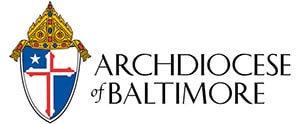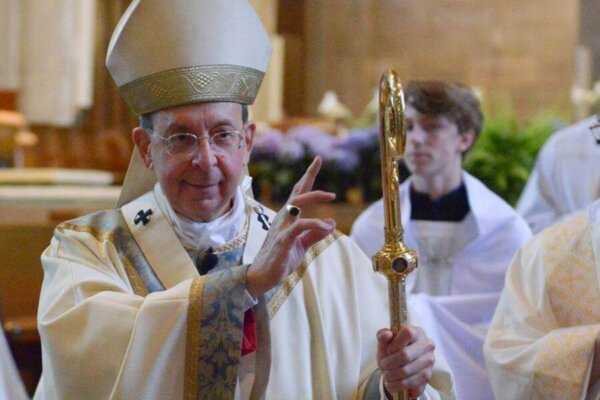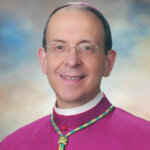Completion of the Interior of the Brick Chapel
Remarks by Most Reverend William E. Lori, Archbishop of Baltimore
St. Mary’s City, Maryland
April 12, 2025
It is a pleasure to take part in this celebration of the completion of the Brick Chapel. My warmest greetings to my brother bishop, Bishop Roy Campell, to Father Anton, Superior of the Columbiere Jesuit Community in Baltimore, Father David Beaubien, Pastor of St. Aloysious Parish, Father Larry Swink, Pastor of St. Cecila – St. Peter Claver parishes, Delegate Morgan and other distinguished public officials. My special greetings to the Sheriff Steve Hall of St. Mary’s County who happily unlocked the door of the chapel for me and for us all. We are indebted to Dr. Henry Miller – thank you, Dr. Miller, for your love of Maryland history, your tireless research, and your hard work in bringing all of us together today. Indeed, we owe a deep debt of gratitude to all those whose research, skill, and artistry has brought this noble project to completion.
Let me also mention Fred and Beth McCoy. I first met them in 1984 during the observance of Maryland’s 350th anniversary. If you think the weather is bad today, you should have been at the 350th! It rained cats and dogs. We were slipping and sliding on St. Clement’s Island! But back to Fred and Beth. They were a part of the Brick Chapel project from the beginning. Their love of Southern Maryland and its history was infectious.
In the same breath, I must mention the late James Cardinal Hickey who served as Archbishop of Washington from 1980 until 2001. He had a great love and understanding of Maryland history. One of his earliest projects was the restoration of St. Francis Xavier in Newtowne Neck, the oldest parish church in continuous use in the 13 original colonies. I was there when the fabled Ben Bradlee of the Washington Post visited the Cardinal to enlist his support of the Brick Chapel project, including a donation.
Pope Francis designated 2025 as a Jubilee Year of Hope, a year of prayer and celebration centered on the gift of hope, a year of grace for this gift to be stirred up in our minds, our hearts, our spirits. I like to think of Jesuit Fr. Andrew White and all those aboard the Ark and the Dove as pilgrims of hope, those who disembarked at St. Clement Island on March 25, 1634. They came in search of something new – a new life – a life of freedom, a place where they would be free to practice their faith without fear, a place where they could begin a new life for themselves and for their families. Nonetheless, the struggle for religious freedom would be hard-fought.
Less than 10 years after those pilgrims came ashore on the land where we now stand, a woodened chapel was constructed, a tangle expression of their hope. Even though it was burnt down in 1645 by hostile forces, those Maryland colonists did not lose hope. In the 1660’s they constructed for themselves “a good brick chapel”, the first permanent Catholic church in English America. It symbolized their enduring hope for religious freedom. We can well imagine the joy of those first worshippers as they entered the chapel for Mass for the first time in 1667.
As political tides turned in England, so too Maryland’s experiment in religious freedom. Religious freedom in Maryland ceased and the Catholic Church was forcibly suppressed and silenced. In 1704, by order of the Royal Governor, the Brick Chapel was locked by the Sheriff, and was never again to be used for religious purposes. The chapel was dismantled and its bricks were used to construct the manor house at St. Indigoes.
Even so, the hopes of these colonists for religious freedom did not die. The penal laws, the loss of their beloved chapel, other restrictions – none of that resulted in a loss of faith and hope. Quietly but persistently the faith was handed on generation to generation. At the time of the American Revolution, it was alive and well. And such persistence helped pave the way for the recognition of religious freedom in the founding documents of the United States, especially the Bill of Rights. It could be said that these colonists “hoped against hope” for religious freedom.
With the birth of the Constitution and the Bill of Rights came the establishment of the then-Diocese of Baltimore in 1789, the nation’s first Roman Catholic diocese.
Well into this 21st century, let us also be pilgrims of hope. Then as now there are those who would suppress religious freedom, who would seek to privatize religious faith, to limit religious freedom only to freedom of worship, but not to put the teachings of faith into practice in ministries and apostolates of service such as healthcare. Religious freedom is a beautiful gift of God. It is also an American value that recognizes the role of religion in its diversity in a free society and the contribution religion makes to human dignity and the common good. But religious freedom is fragile and easily eroded. So with the same preserving hope as those early Maryland colonists, we must seek to preserve this God-given right, not only for ourselves but for all our fellow citizens and for those generations who will follow us.
Let the unlocking of the chapel and our entry into its interior be for us an expression of hope, hope for the endurance of religious liberty, now and always. Thank you for the privilege of taking part in today’s festivities. May God bless us and keep us always in his love.


